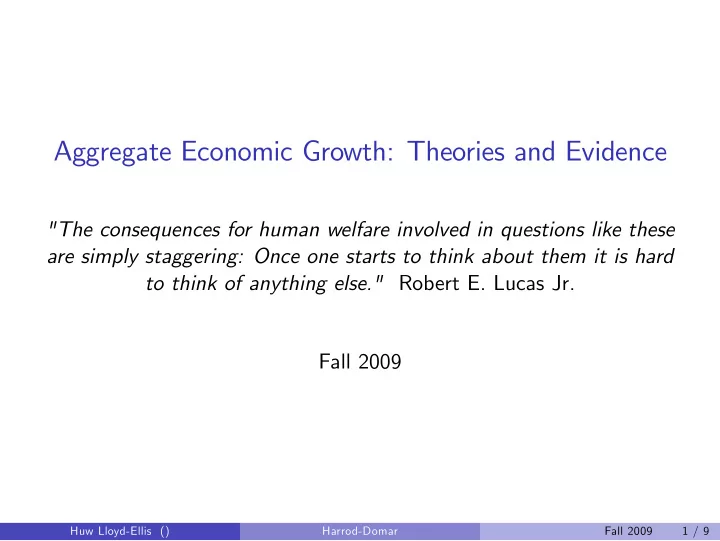

Aggregate Economic Growth: Theories and Evidence "The consequences for human welfare involved in questions like these are simply staggering: Once one starts to think about them it is hard to think of anything else." Robert E. Lucas Jr. Fall 2009 Huw Lloyd-Ellis () Harrod-Domar Fall 2009 1 / 9
Key Questions What accounts for cross–country di¤erences in GNI per capita and 1 labour productivity ? To what extent do the per capita incomes of various countries 2 diverged or converged over time, and what determines this ? What determines long–run growth rates and persistent di¤erences in 3 them across countries ? How do economic institutions and policies impact upon growth ? 4 Huw Lloyd-Ellis () Harrod-Domar Fall 2009 2 / 9
The Harrod–Domar Growth Model Assumes a closed economy with no public sector Aggregate income: Y = C + S where Y = aggregate income C = aggregate consumption S = aggregate saving (private, public and foreign aid) Aggregate ouput: Y = C + I where I = aggregate investment Huw Lloyd-Ellis () Harrod-Domar Fall 2009 3 / 9
Macroeconomic balance: S = I Evolution of the aggregate capital stock: ∆ K = I � δ K Behavioural assumptions: , ! constant savings rate: S Y = s , ! constant capital–output ratio (ICOR): K Y = v Huw Lloyd-Ellis () Harrod-Domar Fall 2009 4 / 9
Implied growth in output: ∆ Y = ∆ K = I � δ K Y K K g = I K � δ = sY vY � δ g = s v � δ ) Harrod–Domar equation: s = v ( g + δ ) Viewed as a “recipe”: given values for v and δ , what value of s is required to achieve a “target” value of g ? Huw Lloyd-Ellis () Harrod-Domar Fall 2009 5 / 9
Adjustment for population growth Let L = population Assume constant population growth: ∆ L L = n The growth in output per person is ∆ Y � ∆ L g � = Y L = g � n ) adjusted Harrod–Domar equation: s = v ( n + g � + δ ) Huw Lloyd-Ellis () Harrod-Domar Fall 2009 6 / 9
Numerical example: Country saves 20% of income: s = 0 . 2 Capital–output ratio of 4: v = 4 Rate of depreciation is zero: δ = 0. Rate of growth of total GNP: s g = v � δ 0 . 2 = 4 � 0 = 0 . 05 If population growth were 3% per year, what saving rate is needed to achieve a growth rate per capita of 4% per year? v ( g � + n + δ ) s = = 4 ( 0 . 04 + 0 . 03 ) = 0 . 28 Huw Lloyd-Ellis () Harrod-Domar Fall 2009 7 / 9
Application to Foreign aid “The …nancing gap model” Overall saving rate with foreign aid: Y = S D s = S Y + A Y Given v , n , δ and domestic saving, S D , how much foreign aid, A , is needed to acheive a target per capita growth rate ? , ! Harrod–Domar formula: A = v ( g � + n + δ ) Y � S D Huw Lloyd-Ellis () Harrod-Domar Fall 2009 8 / 9
Problems with the Harrod-Domar model Empirical link between investment rate and short–run growth is weak Empirical link aid and investment rate is weak (see Easterly ch. 2) Assumes “surplus labour” Most estimates …nd diminishing marginal returns to capital ) cannot have a constant capital–output ratio, v , as economy grows, unless there is “technical change” (Solow model) Savings rate, s , and population growth rate, n , vary with income level (endogenous ?). Huw Lloyd-Ellis () Harrod-Domar Fall 2009 9 / 9
Recommend
More recommend